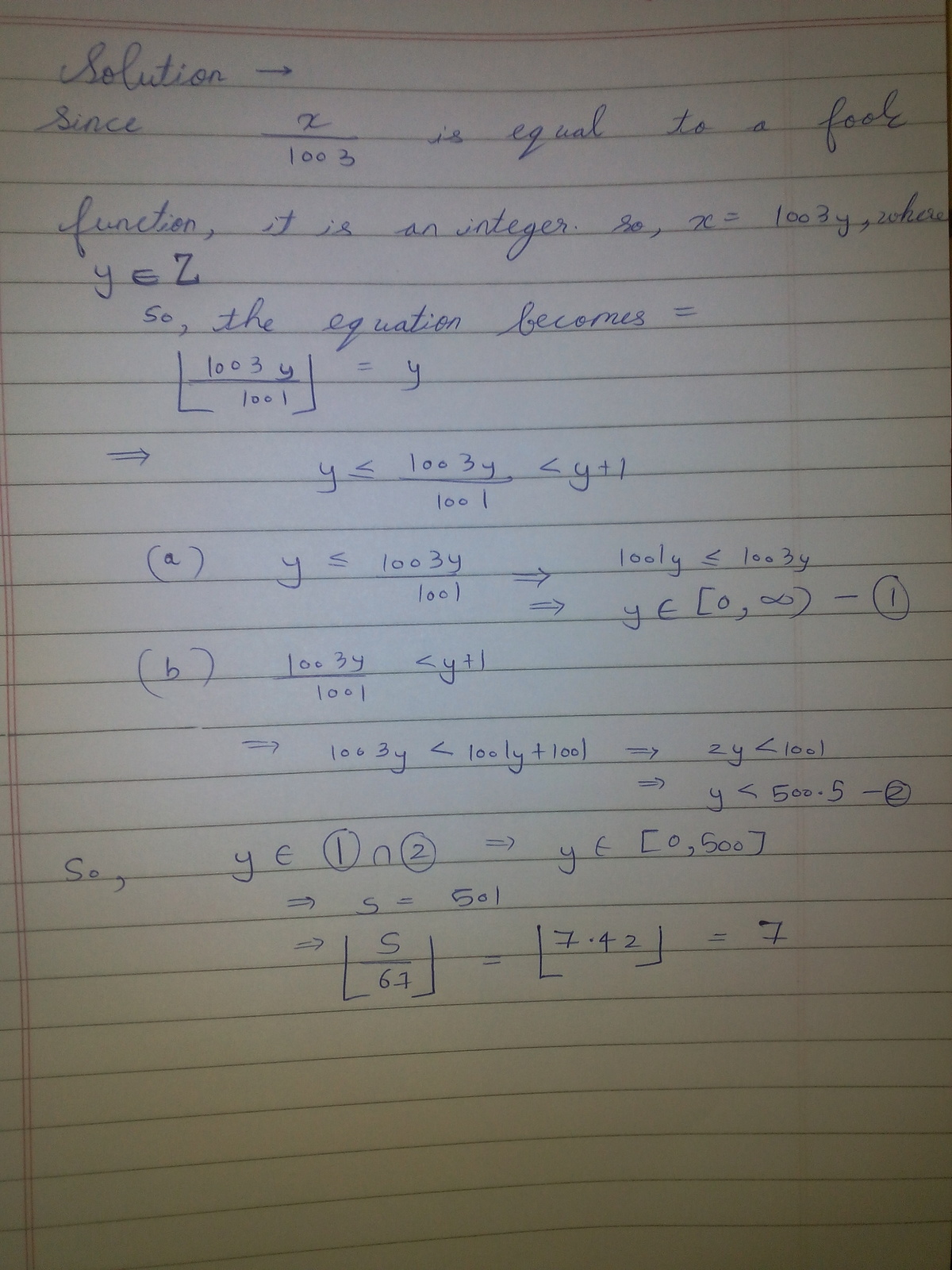I love floor function
Let S denote the number of solutions that satisfy the equation ⌊ 1 0 0 1 x ⌋ = 1 0 0 3 x . Find ⌊ 6 7 S ⌋ .
The answer is 7.
This section requires Javascript.
You are seeing this because something didn't load right. We suggest you, (a) try
refreshing the page, (b) enabling javascript if it is disabled on your browser and,
finally, (c)
loading the
non-javascript version of this page
. We're sorry about the hassle.
2 solutions
Very impressive. But I wonder, why do you exclude negative values of X? Aren't there also 500 negative values of X for which this equality holds true? (-1003, -2006, -3009, etc.?)
Log in to reply
In my solution when I assumed n as a variable I have specified that n is any integer so when I finally found the range for n it naturally came out n>0. If you are not satisfied you can check by using a calculator like for -1003 the L.H.S will be -2 where else R.H.S will be -1. Same will be true for other values also. If you are still not sure use desmos (graphing calculator) put the equation in the form floor(x/a)=x/b (b>a)where a and b can change values. You will notice that there are no real solutions possible for x<0. If you still have any other doubt please tell me.
the floor is defined as follows for any x ∈ R : it is the unique integer k such that k ⩽ x < k + 1 . From there you can see that the negative values should not be added (because for k > 0 , − k 1 0 0 1 1 0 0 3 < − k , so we never have this equality !)
In my solution to this equation(I have attached a photo in my solution) , I deal with 2 inequalities at the same time and the solution to this is the intersection of solution set of both the inequalities.From first inequality,(refer inequality "a") we get to the conclusion that any integer to be the solution of the equation has to be non-negative (so 0 is also a solution but no negative numbers)
Exactly the same
I have attached my solution in the form of image file

S i n c e L . H . S h a v e a f l o o r f u n c t i o n S o R . H . S m u s t a l s o b e a n i n t e g e r . S o x m u s t b e a m u l t i p l e o f 1 0 0 3 . R e p l a c e x b y 1 0 0 3 n w h e r e n i s a n y i n t e g e r . S o o u r e q u a t i o n b e c o m e s ⌊ 1 0 0 1 1 0 0 3 n ⌋ = n N o w , u s i n g ⌊ x ⌋ = x − { x } ( h e r e { x } r e p r e s e n t s f r a c t i o n a l p a r t o f x ) W e h a v e , 1 0 0 1 1 0 0 3 n − { 1 0 0 1 1 0 0 3 n } = n O n s i m p l i f i c a t i o n w e g e t , 1 0 0 1 2 n = { 1 0 0 1 1 0 0 3 n } N o w u s i n g 0 ≤ { x } < 1 , W e g e t 0 ≤ n < 5 0 0 . 5 ∴ n c a n t a k e 5 0 1 v a l u e s . H e n c e S = 5 0 1 ⌊ 6 7 5 0 1 ⌋ = 7